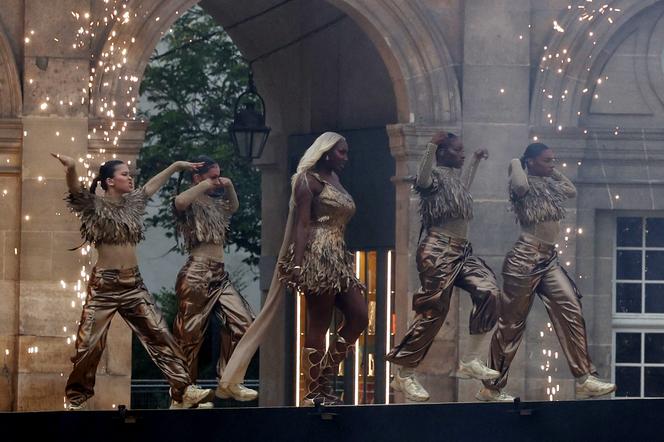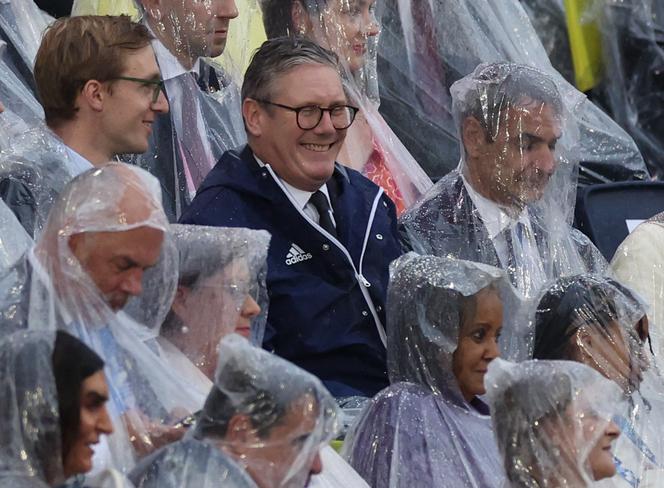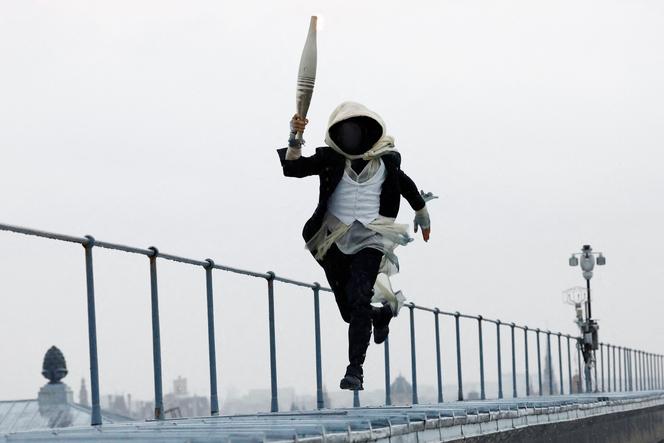
Eighty Moulin Rouge dancers, heavy metal, Aya Nakamura, and, of course, the almost 100 boats on which some six to seven thousand athletes sailed down the River Seine: The first Olympics opening ceremony to take place outside of a stadium was certainly a memorable one. It sought to proudly showcase French culture with a modern twist and was filled with highlights and unprecedented moments.
The uninvited rain
Braving torrential rain, some 300,000 people had lined the river banks to cheer on the armada carrying competitors past the city’s iconic sights: the Eiffel Tower bearing the five Olympic rings, the Louvre, and Notre Dame Cathedral.
The wildly ambitious display was the first time the Olympic opening ceremony had been staged outside a stadium, making it the biggest-ever launch for the “Greatest Show on Earth”. But that gamble also made the ceremony hostage to the weather, with spectators, VIPs, and athletes alike soaking wet.
Renowned French classical pianist Alexandre Kantorow was drenched as he performed on a Paris bridge without any cover, while social media users expressed concern for his equally unprotected instrument. Ironically, the piece he played was Jeux d’eau (“Water Game”) by Maurice Ravel.

An image of Britain’s new Prime Minister Keir Starmer meanwhile went viral showing him refusing to wear the standard plastic poncho to stay dry – showing classic British defiance in the face of poor weather.
Raving in the rain
As the night set over Paris, dancers lit up the Seine in a rave-like ambiance as rain poured down onto the stage, with the Passerelle Debilly bridge glowing in neon pink in the background.
Drag queen Piche, known for her participation in the second season of Drag Race France, danced to Freed From Desire by Gala, followed by prima ballerina Germain Louvet and waacking dancer Princess Madoki. Drag Race France host Nicky Doll lipsynced to Dalida’s Paroles Paroles, and GG Palmer put on a wild voguing performance on the soaking wet stage.
The great comeback
An emotional climax was reached when Canadian singer Céline Dion, who had been battling a rare illness – the stiff person syndrome, a rare neurological condition that causes painful muscle spasms –, made a spectacular comeback by singing from the Eiffel Tower L’hymne à l’amour by Edith Piaf, with her musical director Scott Price at the piano.
Showing pitch-perfect intonation and hitting the notes with ease, she serenaded a captive Paris as the cauldron lit by France’s most-decorated track athlete Marie-José Pérec and three-time Olympic gold medal-winning judoka Teddy Riner soared into the Paris sky in a balloon. Dion first disclosed in December 2022 that she had been diagnosed with Stiff Person Syndrome.
A French classic
Some 80 artists from the celebrated Moulin Rouge cabaret performed the iconic cancan dance that dates back to the 1820s, in pink costumes specially designed for the occasion. The famous music however was given a new electronic touch that set the tone for an evening that sought to put a new twist on classic French culture.
New
Le Monde’s app
Get the most out of your experience: download the app to enjoy Le Monde in English anywhere, anytime
Download
As the teams began their parade down the Seine they were serenaded by an accordion player – dressed in the stereotypical French outfit of béret and blue-striped T-shirt – precariously perched on a bridge.
Defying discrimination
There had been a racist backlash on social media and criticism from the far-right when it emerged that French Malian singer Aya Nakamura was to perform at the opening ceremony – Rassemblement National politicians went as far as to suggest that her appearance would “humiliate” France.
But with President Emmanuel Macron himself backing her involvement, she and her dance troupe swung their way into a medley of her hits and a song by the great Charles Aznavour. In an eloquent symbol, she received backing from the musicians of France’s Republican Guard and performed against the backdrop of the Académie Française, the austere guardians of the French language.
A sequence of dancing promoting tolerance of sexual and gender identities ended with the actor Philippe Katerine appearing as the Greek God Dionysus naked, painted in blue, with strategically placed flowers covering his modesty.
Pioneering French women celebrated
True to its slogan “Games Wide Open”, the Paris Olympics can boast gender equality for the first time ever – 50% of the athletes are female. For comparison, during Paris 1924, the last time the Olympics took place in the city, they were 4%.
And in possibly Jolly’s greatest coup de théatre of the entire ceremony 10 statues of pioneering French women surged up from the waters of the Seine in a bid to inscribe their achievements in minds forever. They included the French writer and activist Olympe de Gouges who was guillotined in 1793, Simone Veil, a Holocaust survivor who spearheaded the legalization of abortion in France, feminist activist Gisèle Halimi, and athlete Alice Milliat.
First metal band ever
No one could accuse the opening ceremony of being rigid in its choice of music with the city pulsating to all styles from classical, to opera, to pop to electro.
Lady Gaga delivered a dazzling performance as the first musical act of the ceremony – except it was all prerecorded. She sang Zizi Jeanmaire’s Mon Truc en Plumes. Gaga’s appearance was a surprise – she was not listed on a program provided to the media in advance – but was heavily rumored after the singer and actor was spotted in Paris.
But perhaps the biggest cheer came for the French metal band Gojira who appeared on platforms high on the Conciergerie, an iconic building in the French Revolution, the first time a metal band appeared at an Olympic opening ceremony. They performed a very personal rendition of the French Revolution song Ça Ira.
The mysterious hooded character
Is it from the Phantom of the Opera or Assassin’s Creed? It’s actually both and more. The mysterious torchbearer in a hooded, masked costume was inspired by a number of characters from French culture: Belphégor, the Iron Mask, the titular character from Phantom of the Opera, Fantomas, Ezio from Assassin’s Creed and Arsène Lupin. The torchbearer ran atop the Musée d’Orsay, dashed past Pont Neuf, rode a boat with a kid holding the flame and later cartwheeled down a red runway.

A ceremony with some athletes 10,000 miles away…
Tahitian dancers in palm-leaf skirts mingled with Olympic surfers, locals, and tourists as the opening ceremony for the Summer Games commenced in French Polynesia on Friday morning, some 10,000 miles and 12 time zones away from the main ceremony in Paris.
During one part of the ceremony athletes sealed banana leaves into a vessel, following an ancestral tradition in Polynesian culture – called Rahiri – used as a prelude to important events to secure the peace and union of those competing. During another part of the ceremony, athletes from different countries poured sand into a single communal container, symbolizing unity and respect for the ocean.
The 2024 surfing event in Teahupo’o sets the Olympic record for the competition held furthest away from a host city.